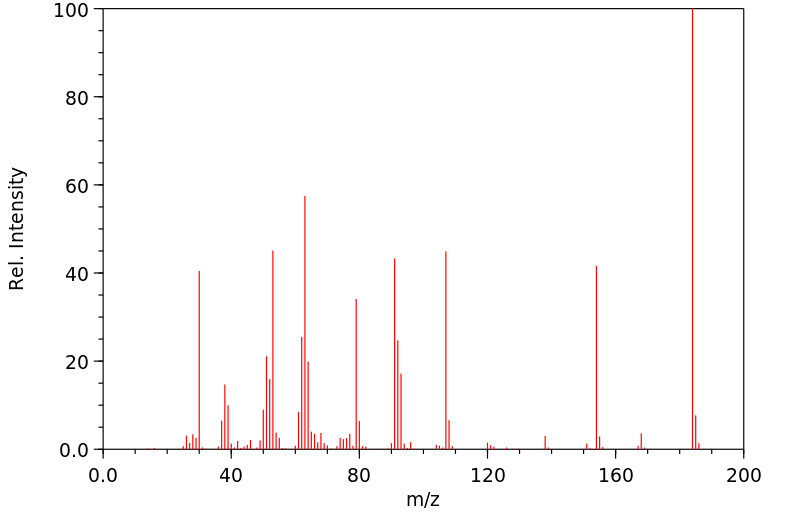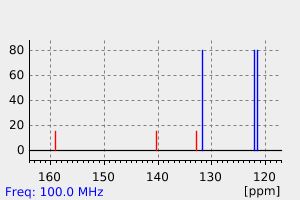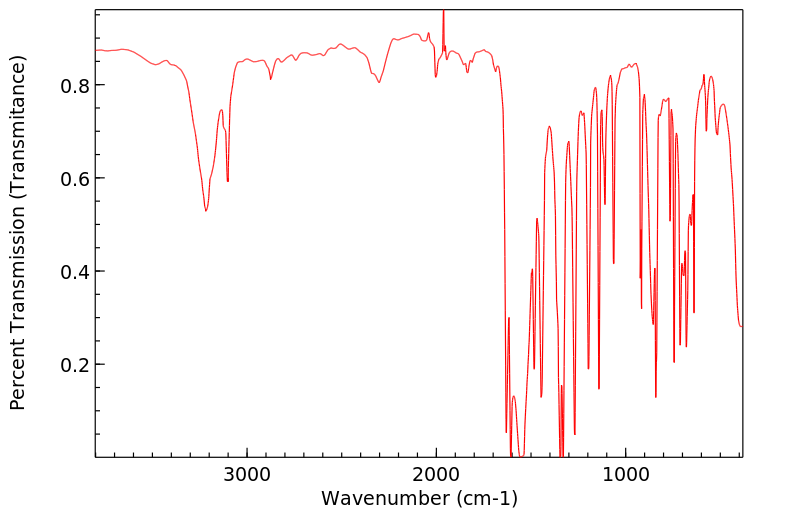2,4-二硝基酚 | 51-28-5
-
物化性质
-
计算性质
-
ADMET
-
安全信息
-
SDS
-
制备方法与用途
-
上下游信息
-
文献信息
-
表征谱图
-
同类化合物
-
相关功能分类
-
相关结构分类
物化性质
-
熔点:112-114 °C
-
沸点:158 °C
-
密度:1.683 g/cm3(Temp: 24 °C)
-
物理描述:2,4-dinitrophenol appears as solid yellow crystals. Explosive when dry or with less than 15% water. The primary hazard is from blast of an instantaneous explosion and not flying projectiles and fragments. slightly soluble in water and soluble in ether and solutions of sodium or potassium hydroxide.
-
颜色/状态:Pale yellow platelets or leaflets from water
-
气味:SWEET, MUSTY ODOR
-
味道:BITTER TASTE
-
溶解度:2790 mg/L (at 20 °C)
-
蒸汽密度:6.35 (NTP, 1992) (Relative to Air)
-
蒸汽压力:3.9X10-4 mm Hg at 20 °C
-
亨利常数:8.60e-08 atm-m3/mole
-
稳定性/保质期:
-
分解:When heated to decomposition it emits toxic fumes of /nitroxides/.
-
燃烧热:648.0 KG CAL/G MOL WT @ 20 °C
-
解离常数:pKa = 4.09
-
保留指数:1492.3;1471
计算性质
-
辛醇/水分配系数(LogP):1.7
-
重原子数:13
-
可旋转键数:0
-
环数:1.0
-
sp3杂化的碳原子比例:0.0
-
拓扑面积:112
-
氢给体数:1
-
氢受体数:5
ADMET
安全信息
-
危险品标志:T,N
-
安全说明:S16,S28,S28A,S36/37,S37,S45,S61,S7
-
危险类别码:R23/24/25,R50,R33
-
WGK Germany:3
-
RTECS号:SL2800000
-
海关编码:29089990
-
包装等级:I
-
危险类别:4.1
-
危险品运输编号:UN 1320 4.1/PG 1
SDS
| 国标编号: | 41010 |
| CAS: | 51-28-5 |
| 中文名称: | 2,4-二硝基苯酚 |
| 英文名称: | 2,4-dinitrophenol;Aldifen |
| 别 名: | 2,4-二硝基酚 |
| 分子式: | C 6 H 4 N 2 O 5 ;HOC 6 H 3 (NO 2 ) 2 |
| 分子量: | 184.11 |
| 熔 点: | 112~114℃ |
| 密 度: | 相对密度(水=1)1.7;? |
| 蒸汽压: | |
| 溶解性: | 不溶于冷水、乙醇、乙醚、丙酮、苯、氯仿 |
| 稳定性: | 稳定 |
| 外观与性状: | 淡黄色固体 |
| 危险标记: | 1(爆炸品) |
| 用 途: | 用于有机合成、染料、炸药 |
2.对环境的影响:
一、健康危害
侵入途径:吸入、食入、经皮吸收。 健康危害:本品直接作用于能量代谢过程,可使细胞氧化过程增强,磷酰化过程抑制。 急性中毒:表现为皮肤潮红、口渴、大汗、烦躁不安、全身无力、胸闷、心率和呼吸加快、体温升高(可达40℃以上)、抽搐、肌肉强直,以致昏迷。最后可因血压下降、肺及脑水肿而死亡。成人口服致死量约1g。 慢性中毒:有肝、肾损害,白内障及周围神经炎。可使皮肤黄染,引起湿疹增皮炎,偶见剥脱性皮炎。
二、毒理学资料及环境行为
毒性:六种异构体以本品毒性为大。 急性毒性:LD5030mg/kg(大鼠经口);700mg/kg(豚鼠经皮);最小致死剂量4.3mg/kg(人经口) 刺激性:家兔经皮:300mg(4周),间歇,轻度刺激。 致突变性:微生物致突变:大肠杆菌200ppm(3小时)。DNA抑制:仓鼠肺脏mmol/L。 生殖毒性:小鼠腹腔志低中毒剂量(TDL0):40800µg/kg(孕10~12天),有胚胎毒性。
危险特性:遇火种、高温、摩擦、震动或接触碱性物质、氧化剂时均易引起爆炸。与重金属粉末能起化学反应生成金属盐,增加敏感度。粉尘在流动和搅拌时,会有静电积累。 燃烧(分解)产物:一氧化碳、二氧化碳、氧化氮。
3.现场应急监测方法:
4.实验室监测方法:
| 监测方法 | 来源 | 类别 |
| 钠盐比色法 | 《化工企业空气中有害物质测定方法》,化学工业出版社 | 化工企业空气 |
| 气相色谱法 | 《城市和工业废水中有机化合物分析》王克欧等译 | 废水 |
| 色谱-质谱法 | 《水和废水标准检验法》19版译文,江苏省环境监测中心 | 水和废水 |
| 色谱/质谱法; 气相色谱法 | 《固体废弃物试验分析评价手册》中国环境监测总站等译 | 固体废弃物 |
5.环境标准:
| 中国(TJ36-79) | 车间空气中有害物质的最高容许浓度 | 1mg/m 3 [皮] |
| 前苏联(1975) | 水体中有害物质最高允许浓度 | 0.03mg/L |
| 前苏联(1975) | 渔业水体中有害物质最大允许浓度 | 0.03mg/L |
| 前苏联 | 污水中有害物质最高允许浓度 | 4mg/L |
6.应急处理处置方法:
一、泄漏应急处理
隔离泄漏污染区,限制出入。切断火源。建议应急处理人员戴自给正压式呼吸器,穿消防防护服。不要直接接触泄漏物。小量泄漏:避免扬尘,用洁净的铲子收集于干燥、洁净、有盖的容器中。也可以用大量水冲洗,洗水稀释后放入废水系统。大量泄漏:用水润湿,然后收集回收或运至废物处理场所处置。
二、防护措施
呼吸系统防护:可能接触其粉尘时,佩戴头罩型电动送风过滤式防尘呼吸器。 眼睛防护:呼吸系统防护中已作防护。 身体防护:穿紧袖工作服,长筒胶鞋。 手防护:戴橡胶手套。 其它:工作现场禁止吸烟、进食和饮水。工作毕,淋浴更衣。保持良好的卫生习惯。实行就业前和定期的体检。
三、急救措施
皮肤接触:立即脱去被污染的衣着,用大量流动清水冲洗。就医。 眼睛接触:提起眼睑,用流动清水或生理盐水冲洗。就医。 吸入:迅速脱离现场至空气新鲜处。保持呼吸道通畅。如呼吸困难,给输氧。如呼吸停止,立即进行人工呼吸。就医。 食入:饮足量温水,催吐,就医。 灭火方法:遇大火,消防人员须在有防护掩蔽处操作。灭火剂:雾状水、泡沫、二氧化碳。禁止用砂土压盖。
上下游信息
-
上游原料
中文名称 英文名称 CAS号 化学式 分子量 2-氨基-4,6-二硝基苯酚 picramic acid 96-91-3 C6H5N3O5 199.123 苦味酸 2,4,6-Trinitrophenol 88-89-1 C6H3N3O7 229.106 2,4-二硝基苯基羟胺 O-(2,4-Dinitrophenyl)hydroxylamin 17508-17-7 C6H5N3O5 199.123 2,4-二硝基苯甲醚 2,4-dinitroanisole 119-27-7 C7H6N2O5 198.135 2,4-二硝基苯乙醚 2,4-dinitro-1-ethoxybenzene 610-54-8 C8H8N2O5 212.162 2,4-二硝基-1-(4-硝基苯氧基)苯 (2,4-dinitro-phenyl)-(4-nitro-phenyl)-ether 2363-36-2 C12H7N3O7 305.203 2,4-二硝基-1-(苯氧基)苯 2,4-dinitrophenyl phenyl ether 2486-07-9 C12H8N2O5 260.206 硝苯酚 2-hydroxynitrobenzene 88-75-5 C6H5NO3 139.111 1-(2,4-二硝基苯氧基)-2,4-二硝基苯 bis(2,4-dinitrophenyl) ether 2217-56-3 C12H6N4O9 350.201 —— 2,4-dinitrophenyl allyl ether 10242-18-9 C9H8N2O5 224.173 1-[2-(2,4-二硝基苯氧基)乙氧基]-2,4-二硝基苯 1,2-bis-(2,4-dinitro-phenoxy)-ethane 92061-47-7 C14H10N4O10 394.254 4-(beta-甲氧基乙氧基)-1,3-二硝基苯 2,4-dinitrophenyl 2-methoxyethyl ether 67674-33-3 C9H10N2O6 242.188 —— n-Butyl 2,4-dinitrophenyl ether 13417-44-2 C10H12N2O5 240.216 —— 3-Butenyl 2,4-dinitrophenyl ether 1027543-09-4 C10H10N2O5 238.2 —— tert-Butyl-2,4-dinitrophenylether 33696-26-3 C10H12N2O5 240.216 —— 2-(methylthio)ethyl 2,4-dinitrophenyl ether 101219-76-5 C9H10N2O5S 258.255 1-(4-甲基苯氧基)-2,4-二硝基苯 1-(4-methylphenoxy)-2,4-dinitrobenzene 2363-25-9 C13H10N2O5 274.233 —— 2,4-dinitrophenyl 2,4,6-trinitrophenyl ether 5950-87-8 C12H5N5O11 395.199 1-(4-氯苯氧基)-2,4-二硝基苯 1-(4-chlorophenoxy)-2,4-dinitrobenzene 2548-96-1 C12H7ClN2O5 294.651 2-(2,4-二硝基苯氧基)硝酸乙酯 1-(2,4-dinitro-phenoxy)-2-nitryloxy-ethane 62030-34-6 C8H7N3O8 273.159 2,4-二硝基苯酯 2,4-dinitrophenyl acetate 4232-27-3 C8H6N2O6 226.145 —— 1-(3-chlorophenoxy)-2,4-dinitrobenzene 2363-38-4 C12H7ClN2O5 294.651 —— 1-(4-cyanophenoxy)-2,4-dinitrobenzene 32101-47-6 C13H7N3O5 285.216 4-(2,4-二硝基苯氧基)苯甲醛 4-(2,4-dinitrophenoxy)benzaldehyde 794-65-0 C13H8N2O6 288.216 —— 1-(benzyloxy)-2,4-dinitrobenzene 2734-78-3 C13H10N2O5 274.233 1,3-二硝基苯 1,3-Dinitrobenzene 99-65-0 C6H4N2O4 168.109 2,4-二硝基苯酚硫酸盐 2,4-dinitrophenol sulfate 17396-93-9 C6H4N2O8S 264.172 —— 2,4-dinitrophenyl methanesulfonate 7155-37-5 C7H6N2O7S 262.2 (2,4-二硝基苯基)磷酸二氢酯 2,4-dinitrophenyl dihydrogen phosphate 2566-26-9 C6H5N2O8P 264.088 双(2,4-二硝基苯基)碳酸脂 bis(2,4-dinitrophenyl) carbonate 7497-12-3 C13H6N4O11 394.211 (2,4-二硝基苯基)甲基碳酸酯 2,4-dinitrophenyl methyl carbonate 6099-87-2 C8H6N2O7 242.145 (2,4-二硝基苯基)丙-2-烯酸酯 2,4-dinitrophenyl acrylate 62599-74-0 C9H6N2O6 238.156 —— O-ethyl O-(2,4-dinitrophenyl) thiocarbonate 187959-33-7 C9H8N2O6S 272.238 —— carbonic acid ethyl ester-(2,4-dinitro-phenyl ester) 6132-47-4 C9H8N2O7 256.172 2,4-二硝基苯酚丁酸酯 2,4-dinitrophenyl butanoate 24273-19-6 C10H10N2O6 254.199 对硝基苯酚 4-nitro-phenol 100-02-7 C6H5NO3 139.111 —— O-(2.4-dinitro-phenyl)-β-anisaldoxime 53188-16-2 C14H11N3O6 317.258 苯酚,2,4-二硝基-,磷酸(酯)氢 bis(2,4-dinitrophenyl)phosphate 18962-97-5 C12H7N4O12P 430.181 —— [1,4]benzoquinone-mono-[O-(2,4-dinitro-phenyl)-oxime ] 13356-89-3 C12H7N3O6 289.204 —— 2,4-Dinitrophenyl diphenyl phosphate 127414-67-9 C18H13N2O8P 416.284 —— 3-(2,4-dinitrophenoxy)-3-fluoro-3H-diazirine 950487-33-9 C7H3FN4O5 242.123 —— Methyl-2,4-dinitrophenyl-phosphat 29267-42-3 C7H7N2O8P 278.115 双(2,4-二硝基苯基)草酸酯 bis(2,4-dinitrophenyl) oxalate 16536-30-4 C14H6N4O12 422.221 双(2,4-二硝基苯基)己二酸酯 Bis(2,4-dinitrophenyl) hexanedioate 71095-77-7 C18H14N4O12 478.329 —— 2,4-dinitrophenyl octanoate —— C14H18N2O6 310.307 —— Decansaeure-2,4-dinitrophenylester 61063-34-1 C16H22N2O6 338.36 - 1
- 2
- 3
- 4
- 5
-
下游产品
中文名称 英文名称 CAS号 化学式 分子量 2-氨基-4,6-二硝基苯酚 picramic acid 96-91-3 C6H5N3O5 199.123 苦味酸 2,4,6-Trinitrophenol 88-89-1 C6H3N3O7 229.106 2-硝基-4-氨基苯酚 4-amino-2-nitrophenol 119-34-6 C6H6N2O3 154.125 —— 2-nitroso-4-nitrophenol —— C6H4N2O4 168.109 2-氨基-4-硝基苯酚 2-hydroxy-5-nitroaniline 99-57-0 C6H6N2O3 154.125 2,4-二硝基苯基羟胺 O-(2,4-Dinitrophenyl)hydroxylamin 17508-17-7 C6H5N3O5 199.123 2,4-二硝基苯甲醚 2,4-dinitroanisole 119-27-7 C7H6N2O5 198.135 3,5-二硝兒茶酚 3,5-dinitrocatechol 7659-29-2 C6H4N2O6 200.108 6-氯-2,4-二硝基苯酚 2-chloro-4,6-dinitro-phenol 946-31-6 C6H3ClN2O5 218.553 —— chloromethyl 2,4-dinitrophenyl ether 14790-70-6 C7H5ClN2O5 232.58 2,4-二硝基苯乙醚 2,4-dinitro-1-ethoxybenzene 610-54-8 C8H8N2O5 212.162 —— formic acid-(2,4-dinitro-phenyl ester) 61296-01-3 C7H4N2O6 212.119 —— 2,4-dinitrophenyl vinyl ether 7287-46-9 C8H6N2O5 210.146 —— 6-azido-2,4-dinitrophenol 33354-59-5 C6H3N5O5 225.12 2,4-二硝基-1-(苯氧基)苯 2,4-dinitrophenyl phenyl ether 2486-07-9 C12H8N2O5 260.206 —— 2-bromo-4,6-dinitrophenol 2316-50-9 C6H3BrN2O5 263.004 2-(2,4-二硝基苯氧基)乙醇 2-(2,4-dinitrophenoxy)ethanol 2831-60-9 C8H8N2O6 228.161 —— 6-iodo-2,4-dinitrophenol 15968-55-5 C6H3IN2O5 310.005 1-(2,4-二硝基苯氧基)-2,4-二硝基苯 bis(2,4-dinitrophenyl) ether 2217-56-3 C12H6N4O9 350.201 —— 2,4-dinitro-1-prop-2- ynyloxybenzene 10242-20-3 C9H6N2O5 222.157 —— 2,4-dinitrophenoxy-trimethylsilane 62947-23-3 C9H12N2O5Si 256.29 2-(丁基氨基)-4,6-二硝基苯酚 2-(Butylamino)-4,6-dinitrophenol 89563-25-7 C10H13N3O5 255.23 —— 1-bromo-4-(2,4-dinitrophenyloxy)but-2-ene —— C10H9BrN2O5 317.096 6-甲氧基-2,4-二硝基苯酚 2-methoxy-4,6-dinitrophenol 4097-63-6 C7H6N2O6 214.134 2-(2,4-二硝基苯氧基)乙酸 2,4-dinitrophenoxyacetic acid 25141-25-7 C8H6N2O7 242.145 —— 2,4-dinitrophenyl 2,4,6-trinitrophenyl ether 5950-87-8 C12H5N5O11 395.199 —— 3-(2,4-dinitro-phenoxy)-propionic acid 18093-78-2 C9H8N2O7 256.172 1-(4-氯苯氧基)-2,4-二硝基苯 1-(4-chlorophenoxy)-2,4-dinitrobenzene 2548-96-1 C12H7ClN2O5 294.651 —— 2,4-dinitro-(n-hexadecyloxy)benzene 42579-93-1 C22H36N2O5 408.538 1-(4-甲氧基苯氧基)-2,4-二硝基苯 1-(4-methoxyphenoxy)-2,4-dinitrobenzene 2363-27-1 C13H10N2O6 290.232 —— 2,4-dinitrophenyl-n-octyl ether 90885-14-6 C14H20N2O5 296.323 —— (2,4-dinitro-phenyl)-octadecyl ether 64022-29-3 C24H40N2O5 436.592 —— 2,4-dinitrophenyl carbonochloridate 34793-93-6 C7H3ClN2O6 246.564 —— 2-(2,4-dinitrophenoxy)-N,N-diethylethanamine 47074-94-2 C12H17N3O5 283.284 2-(2,4-二硝基苯氧基)乙酰氯 2,4-dinitrophenoxyacetyl chloride 64490-03-5 C8H5ClN2O6 260.59 2,4-二硝基苯酯 2,4-dinitrophenyl acetate 4232-27-3 C8H6N2O6 226.145 —— 2,4-dinitro-(N-methoxy-N-bromomethyl-hydroxylamine)-benzene —— C8H8BrN3O6 322.072 —— glycerol-α.α'-bis-(2.4-dinitro-phenyl ether ) 80211-20-7 C15H12N4O11 424.28 —— 1-(4-cyanophenoxy)-2,4-dinitrobenzene 32101-47-6 C13H7N3O5 285.216 —— 2-ethoxy-4,6-dinitro-phenol 89563-24-6 C8H8N2O6 228.161 —— 1-(benzyloxy)-2,4-dinitrobenzene 2734-78-3 C13H10N2O5 274.233 —— 2-aminomethyl-4,6-dinitrophenol 855588-32-8 C7H7N3O5 213.15 —— (R)‐2‐((2,4‐dinitrophenoxy)methyl)oxirane —— C9H8N2O6 240.172 —— (S)‐2‐((2,4‐dinitrophenoxy)methyl)oxirane —— C9H8N2O6 240.172 2-氯甲基-4,6-二硝基苯酚 2-hydroxy-3,5-dinitrobenzyl chloride 2534-09-0 C7H5ClN2O5 232.58 1,3-二硝基苯 1,3-Dinitrobenzene 99-65-0 C6H4N2O4 168.109 2,4-二硝基苯酚硫酸盐 2,4-dinitrophenol sulfate 17396-93-9 C6H4N2O8S 264.172 —— 2,4-dinitrophenyl methanesulfonate 7155-37-5 C7H6N2O7S 262.2 2-氨基-6-溴-4-硝基苯酚 2-amino-6-bromo-4-nitro-phenol 185335-67-5 C6H5BrN2O3 233.021 —— methyl-carbamic acid-(2,4-dinitro-phenyl ester) 15925-90-3 C8H7N3O6 241.16 (2,4-二硝基苯基)磷酸二氢酯 2,4-dinitrophenyl dihydrogen phosphate 2566-26-9 C6H5N2O8P 264.088 双(2,4-二硝基苯基)碳酸脂 bis(2,4-dinitrophenyl) carbonate 7497-12-3 C13H6N4O11 394.211 (2,4-二硝基苯基)丙-2-烯酸酯 2,4-dinitrophenyl acrylate 62599-74-0 C9H6N2O6 238.156 —— 2,4-dinitrophenyl bromoacetate 135264-58-3 C8H5BrN2O6 305.041 (2,4-二硝基苯基)丙酸酯 propionic acid 2,4-dinitrophenyl ester 32113-35-2 C9H8N2O6 240.172 —— 1,4-bis-(2',4'-dinitrophenoxy)-butan-2,3-diol —— C16H14N4O12 454.307 1-(4-叔丁基苯氧基)-2,4-二硝基苯 (4-tert-butyl-phenyl)-(2,4-dinitro-phenyl)-ether 7462-11-5 C16H16N2O5 316.313 N-(2,4-二硝基苯氧基)乙酰亚氨酸乙酯 ethyl N-(2,4-dinitrophenoxy)acetimidate 54322-32-6 C10H11N3O6 269.214 —— 1-hydroxymethyl-1,2-bis-(2',4'-dinitrophenoxy)-ethane —— C15H12N4O11 424.28 —— (2,4-dinitro-phenyl)-(4-nitro-benzyl)-ether 4279-47-4 C13H9N3O7 319.23 —— O-ethyl O-(2,4-dinitrophenyl) thiocarbonate 187959-33-7 C9H8N2O6S 272.238 —— 2-Bromo-4,6-dinitroanisole 36324-64-8 C7H5BrN2O5 277.031 —— 1-Crotonyloxy-2,4-dinitro-benzol 17450-17-8 C10H8N2O6 252.183 —— Bis(2-cyanoethyl) (2,4-dinitrophenyl) phosphite 310884-61-8 C12H11N4O7P 354.216 2,4-二硝基苯酚丁酸酯 2,4-dinitrophenyl butanoate 24273-19-6 C10H10N2O6 254.199 N-(2-羟基-5-硝基苯基)乙酰胺 2-acetamido-4-nitrophenol 97-60-9 C8H8N2O4 196.163 —— allyl 2,4-dinitrophenyl carbonate 1152444-89-7 C10H8N2O7 268.183 对硝基苯酚 4-nitro-phenol 100-02-7 C6H5NO3 139.111 间硝基苯胺 3-nitro-aniline 99-09-2 C6H6N2O2 138.126 —— 2,6-Dinitro-3-hydroxy-benzonitril 861604-57-1 C7H3N3O5 209.118 —— 2-(2,4-dinitrophenoxy)-5,5-dimethyl-1,3,2-dioxaphosphorinane —— C11H13N2O7P 316.207 双(2,4-二硝基苯基)草酸酯 bis(2,4-dinitrophenyl) oxalate 16536-30-4 C14H6N4O12 422.221 —— 4-(2,4-dinitro-phenoxy)-benzoic acid methyl ester 798-96-9 C14H10N2O7 318.243 双(2,4-二硝基苯基)己二酸酯 Bis(2,4-dinitrophenyl) hexanedioate 71095-77-7 C18H14N4O12 478.329 (2,4-二硝基苯基)十二烷酸酯 2,4-dinitrophenol dodecanoate 64605-44-3 C18H26N2O6 366.414 —— 2,4-dinitrophenol hexadecanoate —— C22H34N2O6 422.522 —— O-stearoyl-2,4-dinitrophenol 159750-13-7 C24H38N2O6 450.576 —— O-arachidoyl-2,4-dinitrophenol 168907-26-4 C26H42N2O6 478.629 —— Decansaeure-2,4-dinitrophenylester 61063-34-1 C16H22N2O6 338.36 2,4-二硝基苯基甲基丙烯酸酯 methacrylic acid-(2,4-dinitro-phenyl ester) 54616-59-0 C10H8N2O6 252.183 (2,4-二硝基苯基)二甲基磷酸酯 dimethyl 2,4-dinitrophenyl phosphate 66391-31-9 C8H9N2O8P 292.142 —— N-(4-hydroxy-3-nitrophenyl)benzamide —— C13H10N2O4 258.233 —— 2,4-dinitrophenyl trifluoromethanesulfonate 32578-27-1 C7H3F3N2O7S 316.171 —— O-undecycenoyl-2,4-dinitrophenol 1026057-11-3 C17H22N2O6 350.371 —— 3-hydroxy-2-hydroxyamino-6-nitro-benzonitrile —— C7H5N3O4 195.134 —— 2-(2,4-Dinitrophenoxy)-1-morpholin-4-ylethanone 139004-67-4 C12H13N3O7 311.251 —— 1-(4-(2-(2,4-dinitrophenoxy)ethoxy)phenyl)-1H-pyrrole —— C18H15N3O6 369.334 —— phenacyl 2,4-dinitrophenyl ether 24042-94-2 C14H10N2O6 302.243 —— O-oleoyl-2,4-dinitrophenol 168907-25-3 C24H36N2O6 448.56 —— 1-(4-(3-(2,4-dinitrophenoxy)propoxy)phenyl)-1H-pyrrole —— C19H17N3O6 383.36 - 1
- 2
- 3
- 4
- 5
- 6
- 7
- 8
- 9
反应信息
-
作为反应物:参考文献:名称:多孔二氧化硅包裹且可磁回收的Rh NP:一种高效,稳定且绿色的催化剂,用于催化转移加氢,并在水中“缓慢释放”化学计量的肼摘要:设计并制备了由多孔二氧化硅包裹的核-壳结构纳米催化剂(Fe 3 O 4 @SiO 2 -NH 2 -RhNPs @ mSiO 2),用于催化硝基化合物转化为相应的胺的加氢反应。Rh纳米粒子充当活性中心,多孔的二氧化硅壳在氢源肼的“缓慢释放”中起着重要的作用。该反应可以在绿色溶剂水中平稳地进行,并且可以通过将水合肼的用量减少至化学计量的1.5当量的底物来改善原子经济性。显着地,获得了高催化效率,并且周转频率(TOF)可以高达4373 h -1在对硝基苯酚(4-NP)的还原中。动力学研究表明,向4-NP的反应顺序为〜0.5,表观活性能E a为58.18 kJ mol -1,这也证明了高催化效率。另外,已经在15个循环后证实了催化剂的优异稳定性,而没有任何催化活性的损失,并且由于Fe 3 O 4核,在反应后易于被磁体回收。DOI:10.1039/c7gc00986k
-
作为产物:描述:参考文献:名称:Datta; Varma, Journal of the Indian Chemical Society, 1927, vol. 4, p. 323摘要:DOI:
-
作为试剂:描述:2-甲基-1-丁烯-3-酮 在 2,4-二硝基酚 、 对甲苯磺酸 作用下, 以 甲醇 、 甲苯 为溶剂, 反应 8.25h, 生成 (E,E)-2,6,10-trimethyl-14-methylene-1,6,10,15-hexadecatetraen-3-one参考文献:名称:全反式无环类异戊二烯信息素成分的合成摘要:全反式无环类异戊二烯骨架是通过两步迭代序列制成的。该方法涉及由烯丙基醇形成的烯丙基乙烯基醚的克莱森重排和甲基异丙烯基酮的二甲基乙缩醛,然后通过重排形成的LiAlH 4还原α,β-不饱和酮。通过使用一锅脱氧反应来合成(E) -β-法呢烯,(E) -β-弹簧烯和树突蛋白,α,β-不饱和酮也被转化为2-甲基-1-丙烯基。DOI:10.1016/s0040-4020(01)86580-7
文献信息
-
[EN] COMPOUNDS FOR USE AS PROTON CHANNELS AND METHODS THEREOF<br/>[FR] COMPOSÉS DESTINÉS À ÊTRE UTILISÉS EN TANT QUE CANAUX DE PROTONS ET PROCÉDÉS ASSOCIÉS申请人:AGENCY SCIENCE TECH & RES公开号:WO2020159441A1公开(公告)日:2020-08-06The present disclosure relates generally to compounds or a salt, solvate, stereoisomer and prodrug thereof for forming synthetic membrane channels. The present disclosure also relates to methods of synthesizing the compounds, methods of forming the synthetic membrane channels and methods of use thereof. In particular, the synthetic membrane channels are synthetic proton channels in a lipid membrane.本公开涉及一般用于形成合成膜通道的化合物或其盐、溶剂化合物、立体异构体和前药。本公开还涉及合成该化合物的方法、形成合成膜通道的方法以及使用方法。具体而言,合成膜通道是位于脂质膜中的合成质子通道。
-
Kinetic Study of the Phenolysis of <i>O</i>-Methyl and <i>O</i>-Phenyl <i>O</i>-2,4-Dinitrophenyl Thiocarbonates and <i>O</i>-Ethyl 2,4-Dinitrophenyl Dithiocarbonate作者:Enrique A. Castro、David Arellano、Paulina Pavez、José G. SantosDOI:10.1021/jo034538+日期:2003.8.1(PDNPTOC), and O-ethyl 2,4-dinitrophenyl dithiocarbonate (EDNPDTC) are studied kinetically in water, at 25.0 degrees C and an ionic strength of 0.2 M (KCl). All reactions show pseudo-first-order kinetics under an excess of phenol over the substrate, and are first order in phenoxide anion. The reactions of EDNPDTC show a linear Bronsted-type plot of slope beta = 0.67, suggesting a concerted mechanism. On the一系列酚与O-甲基O-2,4-二硝基苯基硫代碳酸酯(MDNPTOC),O-苯基O-2,4-二硝基苯基硫代碳酸酯(PDNPTOC)和O-乙基2,4-二硝基苯基二硫代碳酸酯(EDNPDTC)的反应)是在25.0摄氏度的水中和0.2 M(KCl)的离子强度下在水中进行动力学研究的。所有反应在底物上苯酚过量的情况下均显示拟一级反应动力学,并且在酚盐阴离子中为一级反应。EDNPDTC的反应显示斜率β= 0.67的线性布朗斯台德图,表明存在协同作用的机理。另一方面,MDNPTOC和PDNPTOC的酚醛化酶分别显示斜率β= 0.27和0.28的线性布朗斯台德图,这与逐步机理有关,在逐步机理中,阴离子四面体中间体(T(-))的形成决定了速率。通过将所研究的反应的动力学和机理与相似的反应进行比较,得出以下结论:(i)。在中间T(-)中用O(-)取代S(-)会使该物种不稳定。(ii)。将T(-)中的DNPO更
-
A Kinetic Study on Nucleophilic Displacement Reactions of Aryl Benzenesulfonates with Potassium Ethoxide: Role of K<sup>+</sup> Ion and Reaction Mechanism Deduced from Analyses of LFERs and Activation Parameters作者:Ik-Hwan Um、Ji-Sun Kang、Young-Hee Shin、Erwin BuncelDOI:10.1021/jo302373y日期:2013.1.18more reactive than the dissociated EtO–, indicating that K+ ion catalyzes the reaction. The catalytic effect exerted by K+ ion (e.g., the kEtOK/kEtO– ratio) decreases linearly as the substituent X in the benzenesulfonyl moiety changes from an electron-donating group (EDG) to an electron-withdrawing group (EWG), but it is independent of the electronic nature of the substituent Y in the leaving groupPseudofirst一级速率常数(ķ实测值)已经被分光光度法测量为2,4-二硝基苯基X取代的苯磺酸盐的亲核取代反应4A - ˚F和Y取代的苯基苯磺酸5A - ķ在无水乙醇中与EtOK。的解剖ķ实测值成ķ环氧乙烷-和ķ EtOK(即,二阶速率常数,用于与离解的环氧乙烷的反应中-和离子配对分别EtOK,)示出了离子配对EtOK比离解的环氧乙烷反应性更强–,表示K+离子催化反应。随着苯磺酰基部分中的取代基X从给电子基团(EDG)变为吸电子基团(EWG),K +离子产生的催化作用(例如,k EtOK / k EtO –比)线性降低,但是它与离去基团中取代基Y的电子性质无关。通过线性自由能关系对动力学数据进行分析,得出了通过协调机制进行反应的结论(例如,Brønsted型,Hammett和Yukawa-TSuno图)。钾+离子通过通过环状过渡态(TS)增加反应中心的亲电子性而不是通过增加离去基团的
-
一种用于成像和治疗的过氧化氢响应性化合物及其合成方法申请人:中国人民解放军陆军军医大学公开号:CN111635389B公开(公告)日:2023-06-27
-
Catalysis and inhibition of ester hydrolysis in the presence of resorcinarene hosts functionalized with dimethylamino groups作者:Giorgio Cevasco、Sergio Thea、Daniele Vigo、Andrew Williams、Flora ZamanDOI:10.1002/poc.1101日期:2006.10Complexation and catalysis of two calixresorcinarene (RES) derivatives with nucleophilic N,N-dimethylamino functions attached to their upper rims in the hydrolysis of carboxylate and sulfonate esters of 4-nitrophenol and 2,4-dinitrophenol have been investigated. Rate constants obey the complexation equation:
表征谱图
-
氢谱1HNMR
-
质谱MS
-
碳谱13CNMR
-
红外IR
-
拉曼Raman
-
峰位数据
-
峰位匹配
-
表征信息









